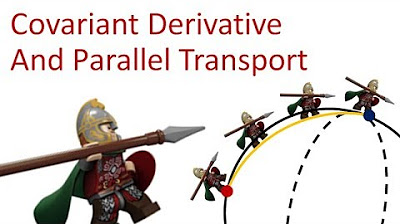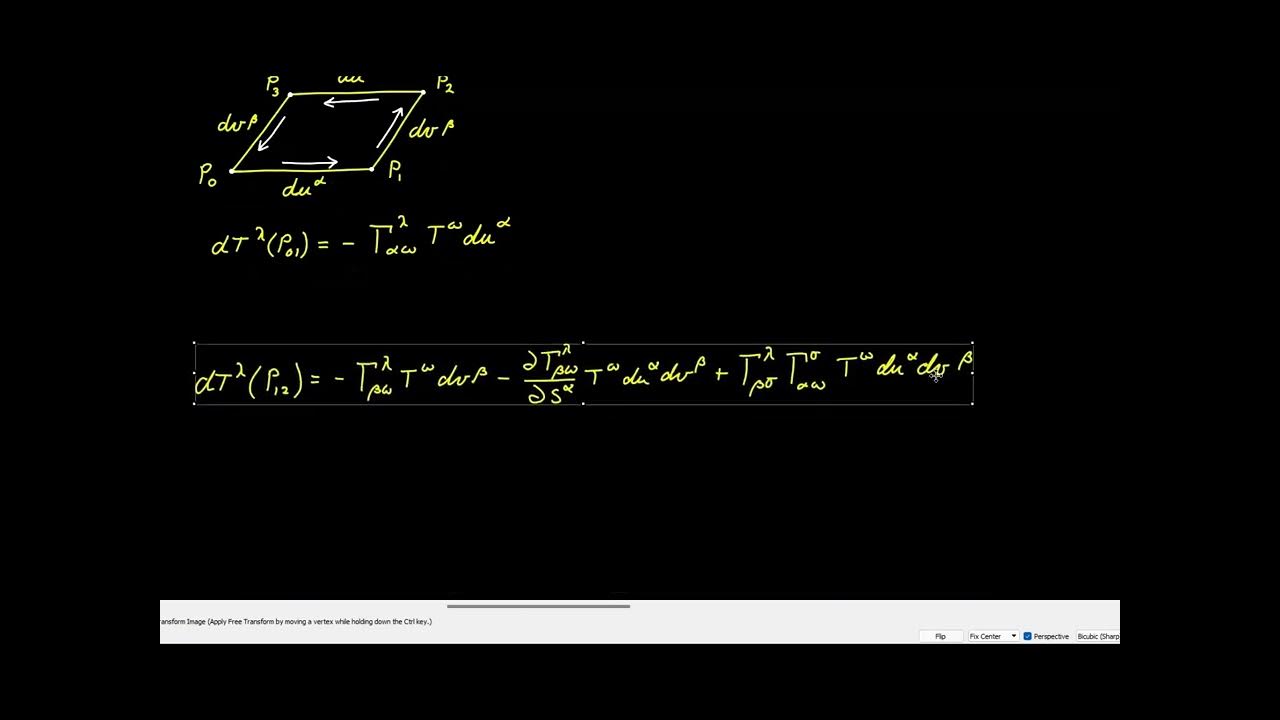Video 96 - Parallel Transport
TLDRThis video introduces the concept of parallel transport in tensor calculus, a method for comparing vectors by moving one along a curve to another point while keeping it parallel to itself. It explains the complexities involved in curvilinear coordinate systems and how parallel transport defines a vector field with constant vectors along the curve. The video also covers the intrinsic derivative, metric compatibility, and the properties of vectors during transport, including their magnitude and angular relationships. It concludes with an alternate definition of a geodesic as a path generated by parallel transporting a vector in its own direction.
Takeaways
- 🚀 The concept of parallel transport is introduced as a method to compare vectors by moving one along a curve to another point while keeping it parallel to itself.
- 📚 In Cartesian coordinates, comparing vectors is straightforward due to constant basis vectors, but this becomes complex in curvilinear coordinate systems like polar coordinates where basis vectors vary.
- 🔍 The process of parallel transport involves defining a vector field along a curve where all vectors are parallel, leading to the condition that the derivative of the vector field with respect to the curve's parameter must be zero.
- 🔗 The chain rule is applied to express the condition for parallel transport in terms of covariant derivatives, connecting it to the concept of the intrinsic derivative discussed in a previous video.
- 📉 The intrinsic derivative measures how a vector or tensor changes along a curve, and for parallel transport, this derivative must equal zero to ensure the vector remains unchanged during transport.
- 📏 In Cartesian or affine coordinates, the condition for parallel transport simplifies to the vector components being constant throughout the process, generalizing the result for curvilinear coordinates as well.
- 🔄 The script discusses the differential form of parallel transport, which is useful for analyzing incremental changes in vector components as the vector moves along the curve.
- 🌐 On curved surfaces, parallel transport is restricted to the tangent plane to avoid introducing normal components, making it a best-effort process given the surface's curvature.
- 🔍 The properties of parallel transport include metric compatibility, where the dot product between two transported vectors remains constant, implying that their angle and magnitude also remain constant.
- 🛤️ A special case is presented where a tangent vector remains tangent throughout the transport process along a geodesic, leading to an alternate definition of a geodesic as a path generated by parallel transporting a vector in its own direction.
- 🔚 The video concludes with a recap of the expressions for parallel transport and a summary of the key properties and definitions related to this concept, setting the stage for a demonstration in the next video.
Q & A
What is the concept of parallel transport in the context of tensor calculus?
-Parallel transport is a technique used to compare one vector to another by moving it along a curve from one point to another while keeping it parallel to itself. It allows for the comparison of vectors in different locations without altering their direction or magnitude.
Why is the simple dragging of a vector from one point to another not sufficient in curvilinear coordinate systems?
-In curvilinear coordinate systems, the basis vectors change from one point to another. Even if two vectors are equal at different locations, their components will differ due to the changing basis vectors, making simple dragging insufficient for accurate comparison.
What is the condition for a vector field during parallel transport along a curve?
-The condition for a vector field during parallel transport is that all vectors along the curve must be parallel to each other. Mathematically, this means the derivative of the vector with respect to the curve's parameter must be zero at every point along the curve.
How is the chain rule applied to analyze the parallel transport of a vector field?
-The chain rule is used to express the total derivative of the vector field as a function of the coordinate system's parameters. It involves the partial derivatives of the vector components with respect to the coordinates, multiplied by the derivatives of the coordinates with respect to the curve's parameter.
What is the intrinsic derivative, and how is it related to parallel transport?
-The intrinsic derivative is an operator defined in the context of tensor calculus to measure how a vector or tensor changes as it moves along a curve. In the case of parallel transport, the intrinsic derivative must be zero, indicating no change in the vector as it is transported along the curve.
What property of parallel transport ensures that the magnitude of a vector remains constant throughout the process?
-The metric compatibility property ensures that the dot product between two vectors being transported together remains constant, which implies that the magnitude of each individual vector remains unchanged during the parallel transport process.
How does the concept of parallel transport apply to curved surfaces?
-On curved surfaces, parallel transport is used to compare vectors that lie in the tangent plane at different points. The process must restrict the vector to the tangent plane throughout, ignoring any normal curvature effects, to ensure accurate comparison.
What is the significance of the geodesic in the context of parallel transport?
-A geodesic is a curve along which a tangent vector, when parallel transported, remains tangent throughout the process. It represents the shortest path between two points on a curved surface and is defined by the condition that a vector parallel transported in its own direction generates the geodesic.
How does the angle between two vectors being parallel transported change?
-Due to the metric compatibility property, the angle between two vectors being parallel transported together remains constant throughout the process, even as they move along a curve.
What form of the intrinsic derivative is useful for analyzing the incremental change of a vector component during parallel transport?
-The differential form of the intrinsic derivative, which expresses the change in the vector component as a function of the tangent vector and the Christoffel symbols, is useful for analyzing incremental changes during parallel transport.
Outlines
📚 Introduction to Parallel Transport in Tensor Calculus
This paragraph introduces the concept of parallel transport, a method for comparing vectors by moving one along a curve to another point while keeping it parallel to itself. It contrasts this with the common misconception of 'dragging' a vector from one location to another, which is not valid in curvilinear coordinate systems like polar coordinates. The basis vectors change from point to point, affecting the components of the vectors even if they are equal in magnitude and direction. The paragraph establishes the condition for parallel transport as the derivative of the vector field being zero along the curve, which is analyzed using the chain rule and covariant derivative, linking back to previous discussions on the intrinsic derivative in video 41.
🔍 Analyzing Parallel Transport and Its Application on Curved Surfaces
The second paragraph delves into the specifics of parallel transport, especially in the context of Cartesian and curvilinear coordinates. It explains how the intrinsic derivative, previously introduced, is used to ensure that the vector components remain constant during transport, which is a requirement for parallel transport. The paragraph also addresses the complexities of performing parallel transport on curved surfaces, emphasizing the need to keep the transported vector within the tangent plane to avoid introducing normal components. It reiterates the use of the intrinsic derivative in this context and highlights the importance of understanding how basis vectors change along the curve when dealing with curvilinear coordinates.
🌐 Properties of Parallel Transport and Geodesics
This paragraph explores the properties of parallel transport, focusing on metric compatibility, which states that the dot product between two vectors remains constant during transport, implying that their magnitudes and the angle between them are preserved. The discussion extends to the special case of a vector tangent to a curve and how it can reveal information about the curve's nature. The paragraph introduces the concept of geodesics, showing that a vector transported along a geodesic remains tangent to it, and uses this to derive an alternate definition of a geodesic as a path generated by parallel transporting a vector in its own direction.
📘 Recap and Further Exploration of Parallel Transport
The final paragraph of the script serves as a recap, summarizing the key points discussed in the video about parallel transport. It reiterates the conditions for parallel transport, the implications of metric compatibility, and the role of geodesics in this process. The paragraph also hints at a future demonstration of these concepts through a specific example, promising a deeper understanding of how parallel transport operates in practical scenarios.
🙏 Conclusion and Thanks
The concluding paragraph is a simple expression of gratitude to the viewers for watching the video. It does not contain any technical content but serves as a polite and customary ending to the educational content presented.
Mindmap
Keywords
💡Parallel Transport
💡Curvilinear Coordinate System
💡Basis Vectors
💡Vector Field
💡Covariant Derivative
💡Intrinsic Derivative
💡Metric Compatibility
💡Geodesic
💡Christoffel Symbols
💡Tangent Vector
💡Arc Length
Highlights
Introduction to the concept of parallel transport in tensor calculus.
Explanation of comparing vectors by transporting one parallel to itself along a curve.
Clarification on the misconception of dragging vectors in Cartesian coordinates versus curvilinear coordinate systems.
The basis vectors' inconsistency in different locations within a curvilinear coordinate system.
Defining a vector field with the condition that vectors along the curve are parallel to each other.
Use of the chain rule to analyze the derivative of a vector field with respect to a parameter.
Linking the covariant derivative to the analysis of parallel transport.
Recalling the intrinsic derivative from a previous video as part of the parallel transport process.
Condition for parallel transport: the intrinsic derivative must be equal to zero.
Different forms of the intrinsic derivative for analyzing parallel transport in various contexts.
Parallel transport's application to vectors on curved surfaces and the restriction to the tangent plane.
Demonstration of how parallel transport affects vectors on a manifold, especially in tangent planes.
Properties of parallel transport, including metric compatibility and the constancy of the dot product between transported vectors.
Implication of parallel transport on the magnitude and angular relationship of vectors.
Special case analysis where a vector remains tangent to a curve throughout the parallel transport process.
Geodesics as curves generated by parallel transporting a vector in its own direction.
Recap of the video's key points and the mathematical expressions for parallel transport.
Upcoming demonstration of parallel transport concepts in a specific example in the next video.
Transcripts
Browse More Related Video

Video 97 - Parallel Transport Example

Tensor Calculus 18: Covariant Derivative (extrinsic) and Parallel Transport

Tensor Calculus 19: Covariant Derivative (Intrinsic) and Geodesics

Tensor Calculus 22: Riemann Curvature Tensor Geometric Meaning (Holonomy + Geodesic Deviation)

Video 99 - Holonomy Part 2

Parallel transport - Lec 23 - Frederic Schuller
5.0 / 5 (0 votes)
Thanks for rating: